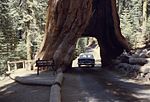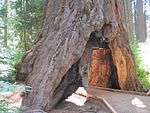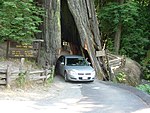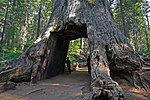Tunnel tree

A tunnel tree is a large tree, typically a giant sequoia or coastal redwood, through which a tunnel has been carved. This practice was primarily carried out in the late 19th and early 20th centuries in the western United States, particularly in California. Tunnel trees were created as tourist attractions, allowing visitors to walk or drive through the tree, often by horse-drawn carriages or automobiles.[1]
The creation of tunnel trees was intended to boost tourism, making the sites iconic landmarks.[1] Examples of tunnel trees are predominantly found in national parks such as Yosemite National Park, and Sequoia and Kings Canyon National Park. Notable examples include the now-fallen Wawona Tree in Yosemite and the Chandelier Tree in Leggett, California.[2]
However, the practice of boring tunnels into living trees caused significant harm to their structural integrity and overall health. Over time, many tunnel trees fell due to the damage inflicted during the tunneling process.[1] As awareness of nature conservation increased, the practice was discontinued. Existing tunnel trees are now preserved as historical artifacts, and no new tunnel trees are being created.[3]
The California Tunnel Tree is the only remaining giant sequoia tunnel tree, while the other three surviving tunnel trees are coastal redwoods.[1]
Today, tunnel trees serve as reminders of an earlier era in American tourism and as examples of the evolving understanding of the importance of conservation and tree preservation.[1]
| Name | Place | Tree species | Note | Picture |
|---|---|---|---|---|
| Wawona Tree | Mariposa Grove, Yosemite National Park | Sequoiadendron giganteum | Yosemite’s Wawona Tree, tunneled in 1881 as a tourist attraction, stood for 88 years before collapsing in the winter of 1968-69. Heavy snow, wet soil, and the tunnel’s weakening effects contributed to its fall. The tree was about 2,100 years old.[4] | 
|
| Pioneer Cabin Tree | Calaveras, Calaveras Big Trees State Park | Sequoiadendron giganteum | The Pioneer Cabin Tree, the third tree to be tunneled, was 1,223 years old when it fell during a powerful winter storm in 2017.[5] | 
|
| Tunnel Log | Sequoia and Kings Canyon National Parks | Sequoiadendron giganteum | The Tunnel Log in Sequoia National Park was created after a giant sequoia fell across Crescent Meadow Road in late 1937 due to natural causes. In 1938, a tunnel was cut through the fallen log to allow vehicles to pass and to serve as a visitor attraction.[4] | 
|
| Chandelier Tree | Leggett | Sequoia sempervirens | The Chandelier Tree, also known as the Drive-Thru Tree, is a 315-foot-tall coast redwood located in Leggett, California. Carved in 1937, its 6-foot-wide tunnel allows vehicles to pass through, making it a popular roadside attraction at the privately owned Drive-Thru Tree Park.[6] | 
|
| Shrine Drive-Thru Tree | Myers Flat | Sequoia sempervirens | Naturally hollowed by fire, the tree was tunneled in the early 20th century for vehicles and became a popular roadside attraction. Renamed in the 1930s, possibly for Shriners International, it shows signs of decline and has been supported by cables since 1942.[7] | 
|
| Klamath Tour-Thru Tree | Klamath | Sequoia sempervirens | The Klamath Tour Thru Tree, carved in 1976, is a drive-through redwood located near Redwood National Park and Yurok tribal lands along the Klamath River, about 60 minutes north of Eureka, California.[8] | |
| California Tunnel Tree | Mariposa Grove, Yosemite National Park | Sequoiadendron giganteum | The California Tunnel Tree, cut in 1895 to accommodate horse-drawn stages, was the second tunnel tree created in Mariposa Grove.[9] Located in the lower grove, it stands below the snowline for longer periods than the Wawona Tree, prompting its selection. Today, it is the last remaining giant sequoia tunnel tree still standing.[10] | 
|
| Dead Giant Tunnel Tree | Tuolumne, Yosemite National Park | Sequoiadendron giganteum | The Dead Giant Tunnel Tree, created in 1878, was the first tunnel tree.[5] It was carved from a dead stump in Tuolumne Grove that already had natural fire caves, making it easy to tunnel through. The tree was created to attract visitors traveling the Big Oak Flat road to Yosemite, which had opened in 1870.[11] | 
|
See also
References
- ^ a b c d e Camila Domonoske (January 9, 2017). "Iconic Sequoia 'Tunnel Tree' Brought Down By California Storm". NPR.
- ^ The drive through trees of California
- ^ "Drive-Through Redwoods Are Monuments to Violent Deforestation". The Atlantic. 2017-01-10. Archived from the original on 2023-03-27.
- ^ a b "The Myth of the Tree You Can Drive Through". National Park Service.
- ^ a b Garrison Frost (May 12, 2023). "The Strange History of the Redwood Tunnel Trees". Save the Redwoods League.
- ^ "Famous Redwoods: Chandelier Tree". Famous Redwoods.
- ^ "Shrine". Famous Redwoods.
- ^ "Drive Through a Redwood". Humboldt California's Redwood Coast. Retrieved 2024-11-29.
- ^ "Grizzly Giant Tour - The Surviving Tunnel Tree". National Park Service. Retrieved 2024-11-29.
- ^ "California - Last Surviving Giant Redwood Tunnel Tree". Famous Redwoods. Retrieved 2024-11-29.
- ^ National Park Service Roads and Bridges Recording Program. National Park Service, United States Department of the Interior. Delineated by Ann Kero, 2001. Historic American Engineering Record CA-117. Accessed November 24, 2024.
